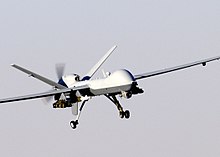Regulation of unmanned aerial vehicles (UAVs) involves setting safety requirements, outlining regulations for the safe flying of drones, and enforcing action against errant users.
The use of unmanned aerial vehicles or drones, is generally regulated by the civil aviation authority of the country. The International Civil Aviation Organization (ICAO) began exploring the use of drone technology in 2005, which resulted in a 2011 report.[1] Ireland was the first country to set a national framework aided by the report and larger aviation bodies such as the FAA and the EASA quickly followed suit, which eventually led to influential regulations in the United States and Europe.[2] As of January 2022[update], several countries are working on new regulations, ranging from BVLOS (beyond visual line of sight, or BLOS) operations to unmanned traffic management (UTM) activities, which include the United States, the Europe Union, India, South Korea, Japan, and Australia among others.[3]

- ^ Cite error: The named reference
Yearbookwas invoked but never defined (see the help page). - ^ Boedecker, Hendrik. "The 2021 Drone Regulation - What is new? What is planned?". Drone Industry Insights. Retrieved 17 May 2021.
- ^ Alvarado, Ed. "Insights on the Latest Drone Regulation 2022 | Droneii.com". Retrieved 2022-01-03.